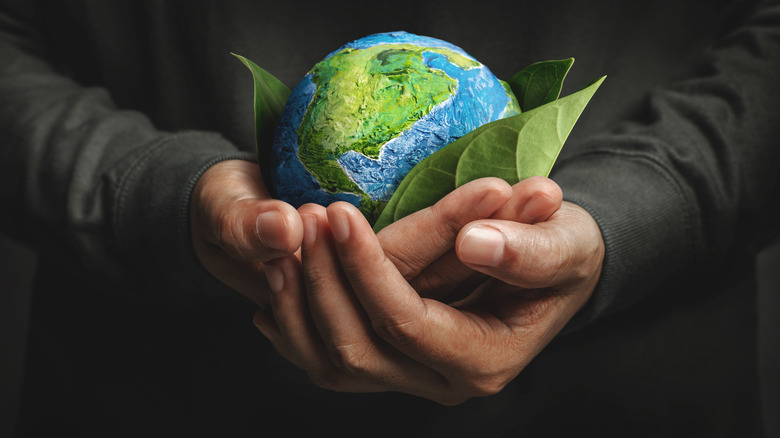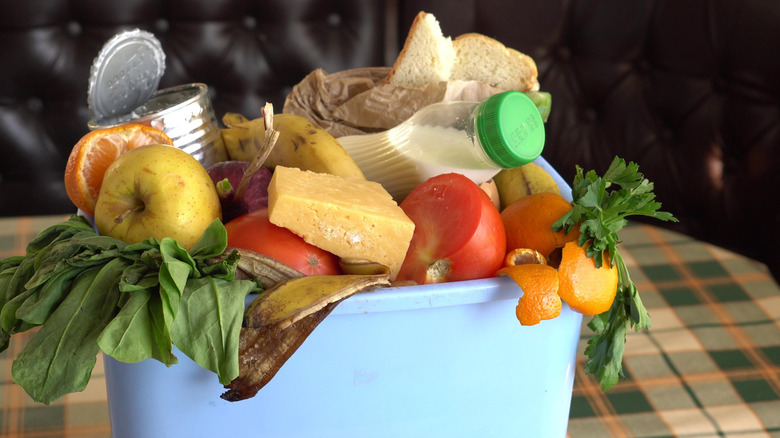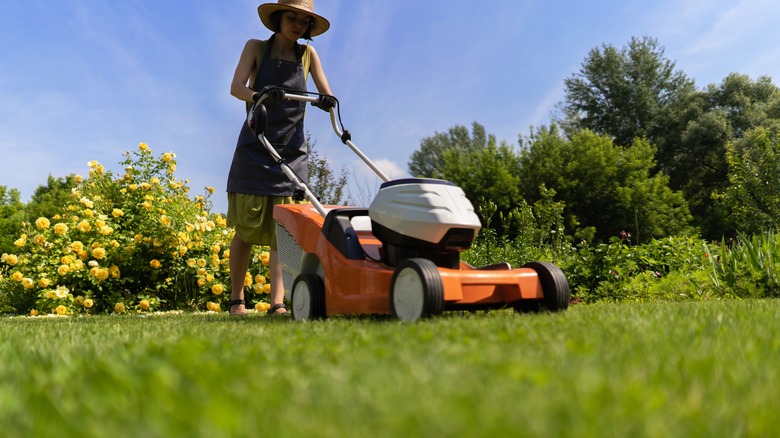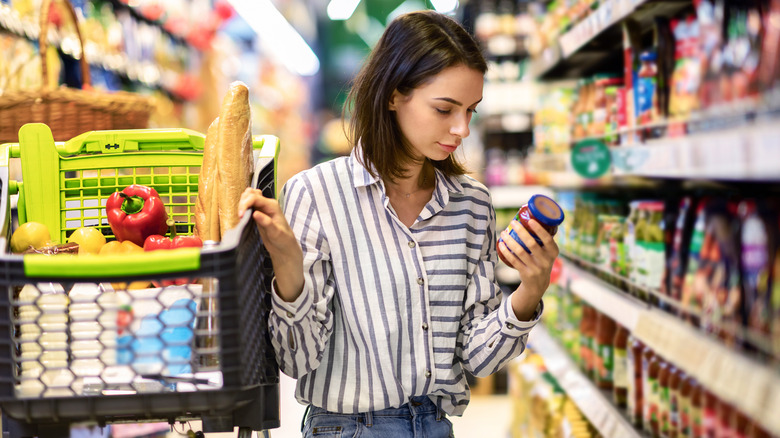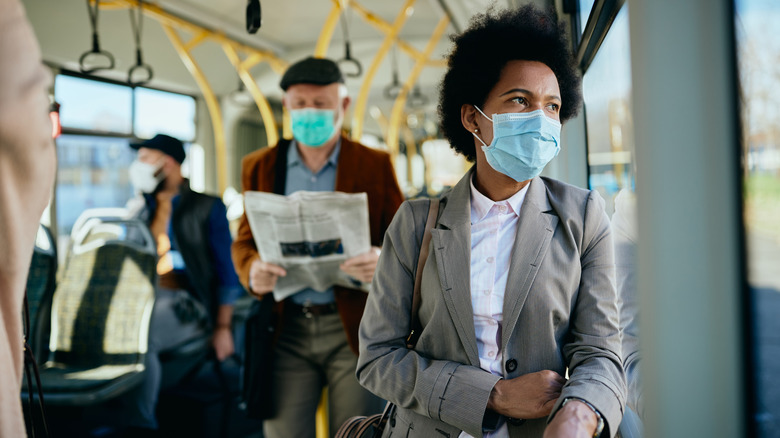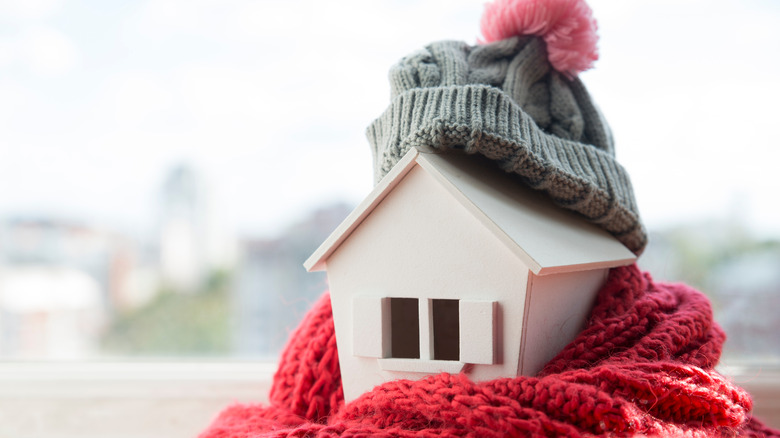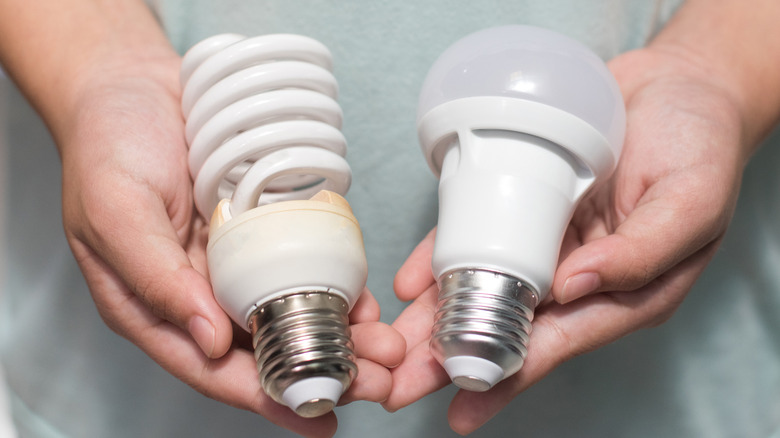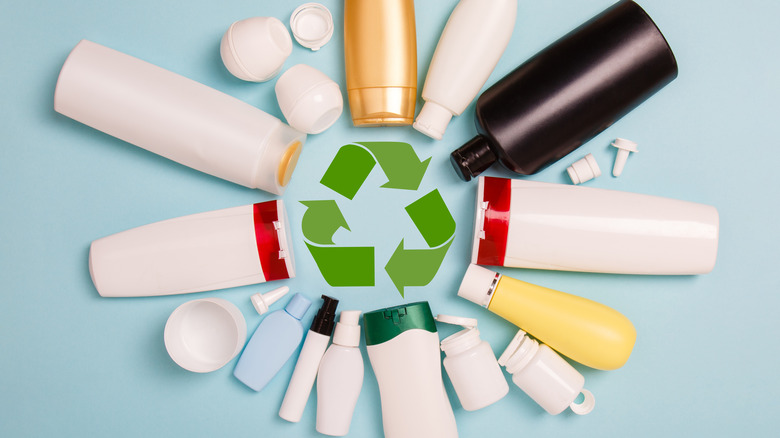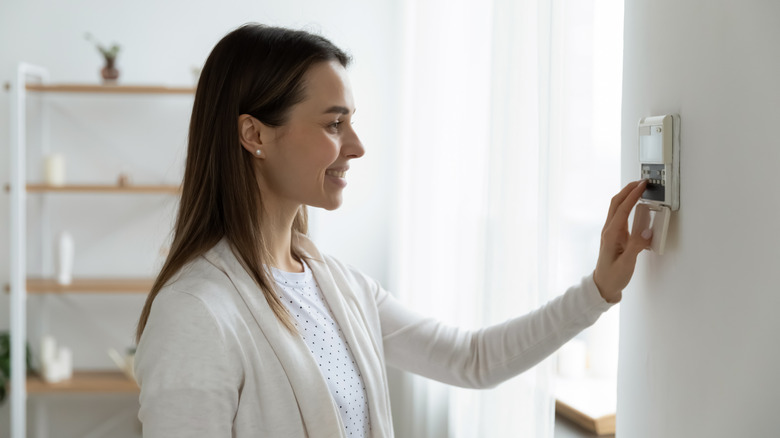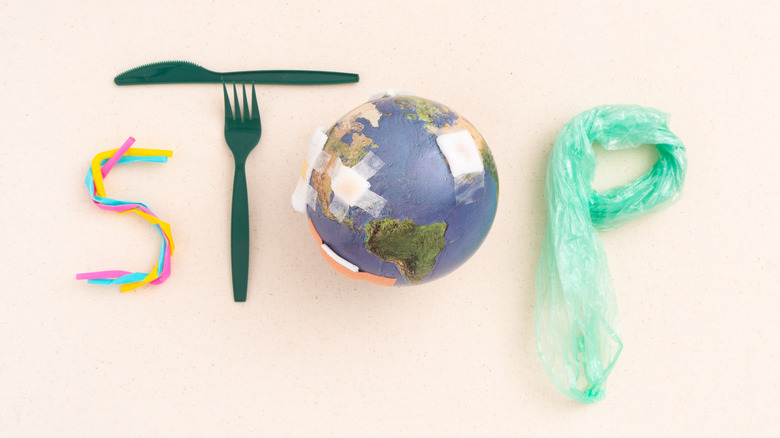12 Small Things You Can Do To Fight Climate Change This Year
The world has observed Earth Day on April 22 since 1970. It serves as a day of reflection where we assess how we can protect the environment and fight climate change, but only being conscious about how we treat the planet once a year is definitely not going to solve the looming climate crisis. It's not something that is in the distant future anymore: Climate change has arrived on our doorsteps.
We can no longer look to governments and big corporations to solve the problem. We as a society need to actively start making changes to our own lives to reduce our carbon footprint. We all have a hand in climate change, and it is time we start taking some steps to ensure we leave a healthy, thriving planet for future generations. Fighting climate change doesn't have to be complicated, and you don't have to upend your whole life — it's all about making some simple changes. Here are 12 small things you can do to fight climate change this year that will reap big results over time.
Check how much food you might be wasting
We might not realize it, but we waste a lot of food on a daily basis. It's a global problem, but one we can easily address at home by checking our own habits. The BBC reports that one-third of the food produced for human consumption ends up wasted. According to the National Resource Defence Council (NRDC), of all the food produced in the United States, 40% ends up making its way to landfills. Yikes!
This is incredibly detrimental to the environment. The NRDC explains that various resources go into producing food in the first place, which already contributes to greenhouse gasses. Food also needs to be packaged (which usually consists of single-use plastics), and tons of water are used during the production process, not to mention various fertilizers. Once you factor in transport and the methane gas emissions foods produce once they make their way to a landfill, you realize how big the problem really is.
So, what can you do to reduce food waste? It's simple: Be more mindful. Actress Nikki Reed, who tries to live a zero-waste lifestyle (per People), told Brightly that the easiest way to get started is to set goals for yourself. "Look at your trash can, and just think for a second: 'How much trash am I producing on a weekly basis,'" she said, adding, "It starts with consciousness. Let's just be aware."
Replace the grass in your yard with native plants
While a lawn looks beautiful, it's not that green when it comes to combating climate change. Not only does grass ask for a lot of maintenance, but it also requires the use of pesticides to keep pesky weeds at bay. The New York Times reports that, according to the Environmental Protection Agency, 59 million pounds of pesticides were used on Americans' lawns to ward off weeds in 2012. While grass may thrive after purging it of unwanted intruders, the environment does not. Pesticides are made from harmful chemicals, some of which end up in waterways, and are damaging to pets and even children. Grass also needs plenty of water, and in America alone, consumers use around 7 billion gallons of water daily to water their lawns. According to a study, maintenance activities usually powered by gas, like mowing and edging, amounted to 26.7 million tons of atmospheric pollutants in 2011.
Needless to say, it would be a good idea to replace grass with native, low-maintenance plants. An article published by the University of Maryland suggests planting groundcovers or even vegetable gardens. Not only will you be able to harvest your own organic veggies, but you'll also be following in the footsteps of celebrities like the Duchess of Sussex, Meghan Markle, who loves growing and harvesting her own vegetables, and former First Lady Michelle Obama, who made headlines planting her own vegetable garden at the White House in 2009.
Buy less stuff
Climate change should make you rethink buying things you don't really need. Research published in the Nature Communications journal found that buying "green" products that have been produced in a sustainable way are not necessarily the answer to climate change. Instead, people need to buy less stuff, period. In fact, according to a paper titled Completing the Picture: How the Circular Economy Tackles Climate Change, we as consumers produce 45% of greenhouse gas emissions ourselves. How? You guessed it: by buying stuff! The things we buy and use on a daily basis, like clothes, food, and cars, are responsible for that terrifying number.
Tom Bailey, an energy and climate expert, and co-founder of The Jump campaign that challenges people to consume less stuff, is of the opinion that we can already make a big dent in climate change by refraining from ditching our electronic devices every couple of years and instead use them for a minimum of seven years, the Guardian reports. Applying this mindset to all the stuff we use on a daily basis (like clothes) can really help out the environment. Take actress Jane Fonda, for example: She told Ellen DeGeneres in an interview that she made a vow to stop buying new clothes in an attempt to "stop all this consumerism" and raise awareness of the impact it has on climate change.
Use public transport or trade your car for an electric vehicle
It's no secret that cars are one of the biggest contributors to greenhouse gasses. That's one of the reasons electric cars were invented. Even though these new types of cars are not in abundance on the road just yet, they're gaining popularity thanks to celebrities like BTS, who have advocated for their use (per People), and Leonardo DiCaprio, who was one of the first celebrities to be seen driving a hybrid model (per E! News).
Trading your gasoline car for an electric or hybrid version will have a significant impact on climate change. According to the Environmental Protection Agency, 29% of greenhouse gasses produced in the United States are attributed to vehicles alone. A German study (via Carbon Brief) found that electric cars can produce up to 43% fewer emissions than their diesel counterpart. Another study showed that these cars' impact on the environment over time is less than that of traditional vehicles. That surely makes owning one worth it.
Of course, not everyone can afford a new electric car, and we're all about making small changes. In this case, using public transportation is a great way to reduce your carbon footprint. According to the U.S. Department of Transportation, national-level data supports claims that public transport helps reduce greenhouse gas emissions. If public transport is not available to you, carpooling is also a great alternative.
Try to eat more plant-based meals
We're all aware that eating more plant-based meals is good for our health, but it's also better for the planet. No one is saying you have to become a vegetarian or vegan, but a 2019 report published in The Lancet explains that doing so would have a very positive impact on climate change. The research showed that eating fewer animal products has a profound impact on the number of greenhouse gasses produced. Opting for a plant-based diet could be just as beneficial, according to a report published by the United Nations Environment Programme. The resources that go into producing animal products are enormous, and in turn produce high amounts of greenhouse gasses, while plant-based products produce significantly less.
Not convinced yet? A study published in Nature Food found that 57% of greenhouse gas emissions globally can be attributed to meat and dairy products, while plant-based foods only contribute around 29%.
The switch is definitely worth it, and it doesn't have to be hard. Actress and animal rights advocate Evanna Lynch went completely vegan in 2013, and her advice to those who want to start incorporating more plants into their diet is simple. "Rather than thinking about what you 'can't' eat on a plant-based diet, focus on what you can eat," she told The Beet in an interview, adding, "It's not helpful to think of it as restrictive."
Make sure your house is properly insulated
When you think about small ways to fight climate change, your house is probably not the first thing that comes to mind. However, according to the Center for Climate and Energy Solutions, houses and commercial buildings actually contribute to a significant amount of greenhouse gas emissions: Cooling and heating these buildings makes up 29% of greenhouse gas emissions in the United States — that's nearly one-third of emissions.
Houses and buildings usually aren't properly insulated. While your house might seem like it's rock-solid, there are most likely small holes and crevices through which cold and warm air can enter and escape. Senior researcher at the American Council for an Energy-Efficient Economy, Rohini Srivastava, told NPR's Life Kit podcast that you can do your part in fighting climate change right at home. Investigate the walls and windows and look for small cracks or holes. These small openings could cost you a lot of extra money when you're trying to keep your house hot or cold during various seasons. In turn, you also burn through more fossil fuels, which contribute to greenhouse gasses.
You can even hire an energy auditor to come check out potential cracks and holes for you. Cheng Vang, who works at the Center for Energy and Environment in Minnesota, told NPR that these auditors can perform what is called a blower door test, which will reveal hidden holes and cracks through which air can escape.
Swap old CFL bulbs for LEDs
Something incredibly simple, easy, and cost-efficient that can help fight climate change is to ensure you use LED bulbs in your house instead of the old CFLs.
A study conducted by the Office of Energy Efficiency & Renewable Energy that compared LED and CFL bulbs found that not only are LED bulbs more cost-effective, but they also directly help people to lower their carbon footprint. Talk about killing two birds with one stone. According to Energy.gov, you can easily reduce electricity use up to 15% by switching to LED bulbs. That amounts to around $255 in savings a year. LED bulbs use around 90% less electricity (how insane is that?) and last 25 times longer than your ordinary CFL bulb, which also results in less waste.
The study found that from the manufacturing process to transportation to usage and disposal, LEDs beat CFLs fair and square. The study also suggested that recycling the aluminum components of the bulbs could help lower their carbon footprint even more.
Walk or cycle whenever you can instead of driving
We've already established that cars are huge contributors to greenhouse gasses, and while opting for an electric vehicle or public transport most definitely will help to fight climate change, there's something else you can do that will bring these types of emissions down to zero: walking.
If you don't drive at all, you won't be contributing to the massive amount of greenhouse gasses that vehicular transportation is responsible for. According to the BBC, a quarter of the world's CO2 emissions are attributed to vehicles. You don't have to get rid of your car, but you can opt to walk short distances instead of driving, according to Stephen Edwards, who is the head of policy and communications at the British Charity, Living Streets. Edwards told the BBC that walking is one of the immediate ways in which people can actively fight climate change, and if they keep it up for long enough, it becomes a habit. A special report released in 2018 by the Intergovernmental Panel on Climate Change (IPCC) urged people to walk and cycle more often, citing the improvement in greenhouse gas emissions the city of London saw after citizens had access to protected cycleways starting in 2003. By 2008, the city saw a 20% reduction in CO2 emissions produced by traffic.
This goes to show that making these small, almost insignificant changes can have a huge impact on climate change.
Recycle as much as you can
One way you can reduce the amount of waste you produce on a daily basis is to recycle as many household items as possible. According to the Environmental Protection Agency (EPA), this will help reduce the amount of waste that eventually ends up in landfills and help slow climate change. Since the items you recycle can be reused, you also indirectly help save water and minerals. Recycling also reduces pollution, because reusing certain materials means that the demand for raw materials decreases.
If you're ready to reduce waste through recycling, the EPA suggests you contact your local municipality or county to find out what your recycling options are. Recycled items can either be picked up at your house, or you might have to take your items to a drop-off center. To make the recycling process easier, you can opt for products in stores that are packaged in materials that can be recycled, or take it one step further and buy goods that have been made with recycled material.
Something else you can recycle or repurpose is clothing. Actress Emma Watson showed the world just how simple (and stunningly beautiful) recycled clothes can be when she appeared at the Earthshot Prize ceremony in London in 2021 wearing a dress made from discarded wedding gowns (per Harper's Bazaar). Watson has long been an advocate for sustainable fashion, and most of us can definitely repurpose our older clothes to create something new, instead of spending money on new items.
Save electricity
Using electricity in itself isn't so bad — it's the way it's generated that is detrimental to climate change. Depending on the generation process, it will contribute to greenhouse gasses, according to the EPA.
CEO of BlocPower, Donnel Baird, told NPR's Life Kit podcast that people can equip their homes with the means to generate their own clean electricity. This can be done by installing solar panels. This is a costly endeavor, but one that is well worth it.
Using electricity that is generated through solar or wind power can reduce your environmental impact, but since that isn't an option for everyone, there are other small things you can do to reduce your energy usage. Rohini Srivastava, senior researcher at the American Council for an Energy Efficient Economy, provided NPR with simpler steps you can take to reduce your power consumption if generating your own electricity isn't an option. This includes refraining from using the AC to cool your home in summer if opening some doors and windows can do the trick, and snuggling up with warm blankets on cold winter nights instead of turning the heat all the way up. Last but not least, you should refrain from keeping your electronic gadgets plugged in when you're not using them. Devices like laptops and televisions can silently suck power even when they're turned off, so either make sure you unplug them or invest in a smart power strip, which will do the power-cutting for you when the device is no longer active.
Try to limit traveling by airplane
Whether you're someone who loves to travel for leisure or frequently need to hop on a plane for work-related travels, you might want to rethink your mode of transport. The aviation industry is responsible for 2.4% of CO2 emissions worldwide, and around 5% of emissions can be attributed to shorter airplane trips, according to the International Council on Clean Transportation (ICCT). You might be thinking, that's not so bad — the numbers for other modes of transport like cars are way worse, after all.
According to Dan Rutherford, ICCT's aviation director, that kind of thinking has it a bit backward. A very small portion of the world's population (around 3%) regularly travels by airplane. In fact, if everyone in the world decided to book only one long-haul flight a year, the CO2 emissions from those flights would be more than the entire United States's CO2 emissions combined. Flying is, by far, the most damaging to climate change than any other mode of transport if you calculate its emissions on a mile-by-mile basis (via BBC).
So, what can you do? Economics professor at Sweden's Linnaeus University, Stefan Gössling, told USA Today that people should refrain from taking flights to travel short distances. He suggests taking a train or bus when your journey is shorter than 600 miles. If you don't have any other choice but to fly, Gössling encourages you to purchase carbon offsets, which will help to reduce greenhouse gasses elsewhere.
Avoid using or buying single-use items
Most of us discard single-use items without even really thinking about it, and it is detrimental to the planet. Takeaway containers, straws, wrappers, and plastic carry bags are some of the biggest culprits. According to the UN Environment Programme, single-use plastics make up half of the plastic produced — and every year, 400 million tons of plastic end up as waste. The worst part is that fossil fuels are used to produce plastic, and it is estimated that plastic production and disposal would contribute to around 19% of greenhouse gasses come 2040. 85% of single-use plastics end up as unregulated waste or make their way to landfills, where they further contribute to greenhouse gasses. Currently, our oceans are home to around 75 to 199 million tons of plastic. Since plastic is not biodegradable, it's not going anywhere, and it's up to us to tackle the problem.
The best thing we can do to limit single-use plastics and fight their effect on climate change and the environment is to simply start reusing the items we can. Actress Niki Reed, who is passionate about zero-waste, told Brightly that bringing your own containers to restaurants and opting for reusable bags at the grocery store is a great start. The UN Environment Programme also urges people to buy items in stores that are not packaged in plastic. Additionally, you can invest in items that are reusable, like coffee mugs and water bottles.
